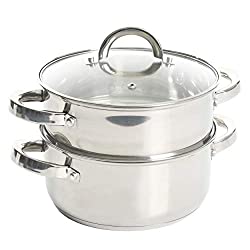Cooking at home, and preparing the dishes to bring to the table with your own hands, without relying on ready meals, is a fundamental step to approach a healthier kitchen and food style. Preparing our dishes we will be perfectly aware of the ingredients present within them. What are the essential tools to use that will be of help, especially to those who are beginners?
To be a success in the kitchen, you need to have the right tools, just like an artist with the right brushes and paints. This is a list of recommended kitchen supplies, utensils, and essentials for Mediterranean cuisine.
Advantages Of Choosing Quality Kitchen Utensils:
- Price: it’s cheaper to buy a good one than 5 bad ones
- Ecology: You buy once and use it for many years
- Cooking to taste: Cooking is a pleasure forget about bad experiences that have their origin in bad kitchen utensils
- Warranty: Any problems you have with the utensil will be covered by the manufacturer’s warranty
The Essential Cooking Tools For Mediterranean Cuisine
The list, if it really includes everything that may be needed in the kitchen, would be kilometers, and then we limit ourselves to compiling a quick handbook to “furnish” your kitchen with the right accessories or at least the indispensable ones.
From the point of view of materials, the containers can be made of stainless steel, aluminum, non-stick material, iron, enameled cast iron, copper, terracotta, porcelain, or enameled glass, each material is suitable for a particular type of cooking food, for example in the oven aluminum is indispensable, which manages to “pass” the heat of the oven almost uniformly to the dish contained, for frying iron pans or those made of non-stick material represent the optimum, and so on.
Couscoussier

Making homemade couscous is extremely time-consuming and labor-intensive, but the taste is far superior to what you find at the grocery store. To steam your couscous, you’ll need a couscoussier, a large double-chamber pan with a built-in steamer. With a couscoussier, you can simultaneously steam couscous in the upper chamber and cook a stew to serve with it in the bottom of the pot, infusing your couscous with the aromas.
Measuring cup:
It will help you measure the volume of liquid, solid, powdered or ground ingredients. It is usually transparent (in plastic or glass material) to facilitate measurement with the help of the metric scales that it has engraved.
Skewers
Middle Eastern cuisine involves a lot of meat cooked on skewers, so it’s essential to keep some on hand. Wooden skewers are suitable if given a good pre-soak, but stainless steel skewers will always be safer and should not be disposed of after each use.
Tagine
Taking its name for the traditional slow-cooked and fragrant stew that cooks indoors, tagines are terracotta containers that have been used since the 9th century. With a cone-shaped lid designed to return condensation to the base, these pots result in very tender meat and vegetables deeply infused with spices. Tagines are often decorated with intricate and colorful patterns, functioning both as a cooking container and as a beautiful serving dish to display on the table.
Ibrik
To make authentic Turkish coffee, you will need an ibrik. An ibrik is what you cook and serve your coffee. It also serves as a large conversation room for your guests during coffee.
An ibrik is a container with a spout used for storing and pouring liquid contents. Although the Turkish word ibrik, derived from Persian through Arabic, denotes simply a pitcher or ewer, the term is often used in English to mean a Turkish coffee pot, which is known in Turkish as a cezve.
Mortar and pestle
A mortar and pestle are good for grinding your own spices and crushing garlic and herbs together. The flavor cannot be reproduced! There are expensive mortars and pestles on the market, but the price does not really indicate the quality. The result comes from the one who uses it, so don’t spend too much on one.
The wok
Originally from Asia, the wok, this large frying pan allows short and tasty cooking. It has become so popular in our kitchens that it has given its name to a type of dish, synonymous with a balanced and exotic cuisine, ideal for sublimating the aromas and textures of vegetables.
The wok would have been born in China, three millennia ago. Designed to save wood and coal, this large jumper has a “chicken’s ass” bottom, traditionally curved (flat in its western version) and always high edges.
The advantage? The assembly guarantees a homogeneous distribution of heat between the bottom and the walls. The wok is ideal for lively, fast, uniform and healthy cooking (the benefits of ingredients, especially vegetables, are preserved), requiring very little fat.
The maintenance of the wok is relatively simple. Be careful not to scratch it to retain its non-stick faculties. A traditional wok requires a little more oil (peanut, rapeseed, sunflower …) during the first cooking (2 to 3 tablespoons) then a thin fatty film is formed to then reduce this fat intake (a single tablespoon is enough).
So be careful not to rub too much by washing it after use. Purists advise against dishwashing products and recommend a simple rinse with water.
Wooden Cutting Board
A wooden cutting board is absolutely necessary to slice fruits, vegetables, and any other food that deserves to be treated with care. Wooden cutting boards last longer than plastic cutting boards, spoil less easily, and are easier to clean. True, there are numerous electronic kitchen tools that can help us slice vegetables in a thousand ways, but manual work, as always, help us not to waste energy and, often, even time.
Wooden spoon
The wooden spoon, in addition to being considered a real symbol of natural cuisine, is probably one of the oldest kitchen utensils. Wood, unlike metal, has the advantage of not being a good conductor of heat, and of being able to be used to mix the foods contained in the pots that are cooking on the stove or stove. A real convenience compared to other metal tools, with which you risk getting burned, or plastic, which inevitably spoils with heat.
Metal bowls
The metal bowls to be used to mix the ingredients for the preparation of the dough are really indispensable and cannot be compared to plastic bowls. They are usually made of stainless steel, are durable, and can accompany you for years. There is no risk of them being ruined, as can happen with plastic bowls. Inside them, it is easier to work the doughs, which will easily detach from their walls.
Colander
Also with regard to the colander, the preferable material to choose is stainless steel, compared to plastic. This is a feature that I will allow us to use not only for draining pasta, rice or vegetables, but also for steaming. It can also be used to wash vegetables or to rinse salad, as well as for home cultivation of sprouts.
A Set Of Quality Knives
Who hasn’t had a fight cutting a piece of meat with an inappropriate knife? Because it is not the same to cut bread than to carve a chicken, it is important to have a set of knives for each use: a bait knife (to cut vegetables, meat, fish fillets), a tip (ideal for small jobs, cut cheese, soft things, etc.) and a boner (to remove chicken breasts, make precise cuts to make steaks, etc.).
Chef’s knife
A well-sharpened and working knife represents, in combination with the wooden cutting board, a tool that allows you to slice bread, vegetables, fruit and all other foods, as well as to chop aromatic herbs, in a simple way, with little effort and without wasting electricity using other means. It is therefore advisable to invest in durable knives, which can be used for many years, also thanks to sturdy handles, which do not spoil in a short time.
A Good Nonstick Skillet (Or Better, A Set Of Various Sizes)
Investing in a good pan is a guarantee of good results and durability. With it you could cook from sauces to elaborate dishes, grilled fish or chips without sticking. To ensure their maintenance as the first day, use wooden or silicone elements to remove on them and do not wash them with metal scourers.
Spoons, Pallets, Ladles
To say the least indispensable, the choice is mainly played on materials and shapes. It is good to think carefully at the time of purchase, without being distracted too much by the design and focusing instead on functionality: size, handles, depth of the ladle basin and so on. As for the materials: for spoons wood is an excellent traditional choice from various points of view, silicone palettes are ideal for turning dishes upside down in non-stick pans without scratching the bottom, steel ladles and skimmers respond perfectly to the need to withstand high temperatures.
Conclusion
Without the proper cooking utensils, preparing meals can be rather frustrating and tiring. One of the main reasons that cooking seems like an uphill task right now might be because you don’t have the right utensils for the different dishes.
Start with buying the basic cooking utensils and slowly move to buy what you are missing. Make a complete list of all the utensils your kitchen needs and buy them one after the other according to how frequently you need them. Within a few months, you will have all the cooking utensils that you need in your kitchen.

